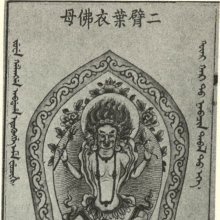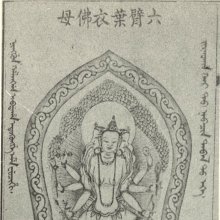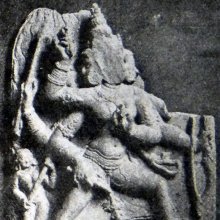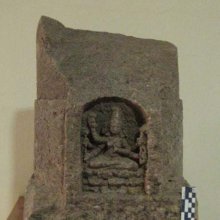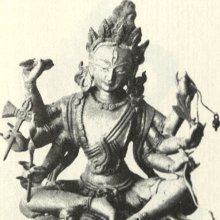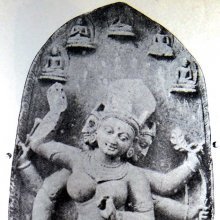Parnashabari, Parṇaśabarī: 5 definitions
Introduction:
Parnashabari means something in Buddhism, Pali, Hinduism, Sanskrit. If you want to know the exact meaning, history, etymology or English translation of this term then check out the descriptions on this page. Add your comment or reference to a book if you want to contribute to this summary article.
The Sanskrit term Parṇaśabarī can be transliterated into English as Parnasabari or Parnashabari, using the IAST transliteration scheme (?).
Images (photo gallery)
(+9 more images available)
In Buddhism
Tibetan Buddhism (Vajrayana or tantric Buddhism)
Source: archive.org: The Indian Buddhist Iconography1) Parṇaśabarī (पर्णशबरी) refers to one of the female emanations of Akṣobhya, as mentioned in the 5th-century Sādhanamālā (a collection of sādhana texts that contain detailed instructions for rituals).—Her Colour is yellow; her Vāhana is vighnas; her Āsana is the pratyālīḍha; she has three faces and six arms.—The worship of Parṇaśabarī, it is believed, is effective in preventing out-breaks of epidemics and in assuring safety to the terror-striken. The epithet ‘Piśācī’ given in the mantra shows that she was regarded as one of the demi-gods, half human, half divine.
Parṇaśabarī when green, emanates from Amoghasiddhi and when yellow from Akṣobhya, and as such, both of her forms have already been described. She is generally three-faced and six-armed but may in rare cases, have four arms also. The peculiarity of the green variety is that all the three faces depict irritated smile (sakrodhahasitānanāṃ). [...] When yellow Parṇaśabarī is an emanation of Akṣobhya, has three faces and six arms, and a pleasant smile instead of an irritated expression on her faces. This form of Parṇaśabarī has also been described under the female emanations of Akṣobhya.
The Dhyāna (meditation instructions) of Parṇaśabarī described in the Sādhanamālā as follows:—
“The worshipper should conceive himself as (Parnasabari) of yellow complexion, with three faces, three eyes and six arms. Her first face is blue, the right white and the left red, and she smiles in a pleasing manner. She is decked in all sorts of ornaments, bears a garment of leaves, is arrogant in her youthful bloom, is stout in appearance and carries in her right hands the vajra, the paraśu and the arrow, and in her left the tarjanī with the noose, the cluster of leaves and the bow. Her jaṭāmukutā is decorated with flowers and the image of Akṣobhya; she has the effulgence of the sun as her aureole, stands in the pratyālīḍha attitude on the moon over the white lotus, trampling under her feet the Vighnas. She threatens the host of (other) Vighnas with the clenched fist of the left hand exhibiting the tarjanī against the chest, and shakes her right fist at (the host of the Vighnas)”.
[The above-mentioned sādhana, further states that Parṇaśabarī may have an alternative form with four arms and the image of Akṣobhya on the crown, in which case she will carry the vajra and the paraśu in the two right hands, and the tarjanī with the noose, and the cluster of leaves in the two left, omitting the bow and the arrow.]
2) Parṇaśabarī (पर्णशबरी) refers to one of the various emanations of Amoghasiddhi, as mentioned in the 5th-century Sādhanamālā (a collection of sādhana texts that contain detailed instructions for rituals).—Her Colour is green; her Vāhana is diseases in human form; her Āsana is the pratyālīḍha; she has three faces.—The Mantra calls her ‘Piśācī’ and also ‘Sarvamāripraśamanī’ or “the destroyer of all diseases and epidemics”. She is almost identical with the form that has been described previously, except that here her colour is green and she bears the image of Amoghasiddhi on her crown, instead of that of Akṣobhya.
The Dhyāna (meditation instructions) of Parṇaśabarī described in the Sādhanamālā as follows:—
“The worshipper should conceive himself as Parṇaśabarī, who has a green complexion, three-faces, three eyes, and six arms. Her right and left faces are of blue and white colour respectively. She carries in her three right hands the vajra, the paraśu and the arrow, and in her three left, the bow, the cluster of leaves and the tarjanīpāśa. Her faces show an angry laugh. She is in the prime of youth, is decked in tiger-skin and a garment of leaves, has a slightly protruding belly, and hair tied up above. She tramples under her feet various diseases and pestilences, and bears the image of Amoghasiddhi on the crown Thus meditating...”
[The two images of Parṇaśabarī have been discovered by Mr. N. K. Bhattasali. These two images follow the sādhana most accurately in all details; the angry laugh has been correctly depicted in the three faces, and the belly slightly protrudes. To the right and left are two divinities, Hayagrīva, the Hindu god of Fever, and Sītalā, the Hindu goddess of small-pox, and they are represented in the images as flying in opposite directions to escape the wrath of Parṇaśabarī. The prostrate figures under the feet are the Diseases and Pestilences, in human shape. The figure under the right leg, apparently, is a man attacked with small-pox, as we can judge from the circular marks all over his body; the other figure under the left foot, is probably attacked with some fatal disease. Both the images of Parṇaśabarī are decidedly very fine specimens of the Bengal school of art.]
3) Parṇaśabarī (पर्णशबरी) refers to one of the twelve Dhāriṇīs according to the 11th-century Niṣpannayogāvalī of Mahāpaṇḍita Abhayākara.—Dhāriṇī is a peculiar kind of Buddhist literature which is supposed to generate great mystic power if repeated continually for a long time. They are short works mostly composed of meaningless syllables, sometimes revealing traces of a language now defunct. [...] The deification of books is not unknown in Buddhism. [...] The Niṣpannayogavālī acknowledges altogether twelve Dhāriṇī (viz., Parṇaśabarī) deities and gives their descriptions. These Dhāriṇīs look alike when represented and they are usually two-armed, holding the Viśvavajra in the right hand and their special symbols in the left.
Parṇaśabarī is described in the Niṣpannayogāvalī (dharmadhātuvāgīśvara-maṇḍala) as follows:—
Source: academia.edu: The Structure and Meanings of the Heruka Maṇḍala“Parṇaśabarī is green in colour and holds in her left hand the peacock’s feathers”.
[Her Colour is green; her Symbol is the peacock’s feathers; she has two arms.—When conceived in the form of deities, the Dhāriṇīs (viz., Parṇaśabarī) are endowed with one face and two arms. They all hold in their right hand the double thunderbolt or the viśvavajra, while in the left they carry their own special symbols.]
Parṇaśabarī (पर्णशबरी) or Parṇasaurika is the name of a Ḍākinī who, together with the Vīra (hero) named Parṇaśabara (or Parṇasaurika) forms one of the 36 pairs situated in the Hṛdayacakra, according to the 10th century Ḍākārṇava chapter 15. Accordingly, the hṛdayacakra refers to one of the four divisions of the sahaja-puṭa (‘innate layer’), situated within the padma (lotus) in the middle of the Herukamaṇḍala. The 36 pairs of Ḍākinīs [viz., Parṇaśabarī] and Vīras are reddish yellow in color; they each have one face and four arms; they hold a skull bowl, a skull staff, a small drum, and a knife.

Tibetan Buddhism includes schools such as Nyingma, Kadampa, Kagyu and Gelug. Their primary canon of literature is divided in two broad categories: The Kangyur, which consists of Buddha’s words, and the Tengyur, which includes commentaries from various sources. Esotericism and tantra techniques (vajrayāna) are collected indepently.
General definition (in Buddhism)
Source: Cambridge Digital Library: Pañcarakṣā, SaptavāraParṇaśabarī (पर्णशबरी) (Parṇaśavarī) or Prajñāpāramitā refers to the fifth of “seven days” (saptavāra) classified as a dhāraṇī according to a 17th-century Sanskrit manuscript from Nepal .—This collection associates each dhāraṇī with a specific day of the week, a tradition going back to at least the sixteenth century in Nepal.
Languages of India and abroad
Sanskrit dictionary
Source: Cologne Digital Sanskrit Dictionaries: Edgerton Buddhist Hybrid Sanskrit DictionaryParṇaśabarī (पर्णशबरी).—(Ārya-)Mañjuśrīmūlakalpa 318.13, or °śavarī, Sādhanamālā 306.11 et alibi, name of a goddess.
Source: Cologne Digital Sanskrit Dictionaries: Monier-Williams Sanskrit-English DictionaryParṇaśabarī (पर्णशबरी):—[=parṇa-śabarī] [from parṇa-śabara > parṇa > parṇ] f. ([probably]) Name of a divine female, [Catalogue(s)]
Sanskrit, also spelled संस्कृतम् (saṃskṛtam), is an ancient language of India commonly seen as the grandmother of the Indo-European language family (even English!). Closely allied with Prakrit and Pali, Sanskrit is more exhaustive in both grammar and terms and has the most extensive collection of literature in the world, greatly surpassing its sister-languages Greek and Latin.
See also (Relevant definitions)
Partial matches: Shabari, Parna.
Full-text: Parnashavari, Parnashabara, Dharini, Parnasaurika, Vajrayogini, Tara.
Relevant text
Search found 2 books and stories containing Parnashabari, Parṇaśabarī, Parnasabari, Parna-shabari, Parṇa-śabarī, Parna-sabari; (plurals include: Parnashabaris, Parṇaśabarīs, Parnasabaris, shabaris, śabarīs, sabaris). You can also click to the full overview containing English textual excerpts. Below are direct links for the most relevant articles:
Related products
